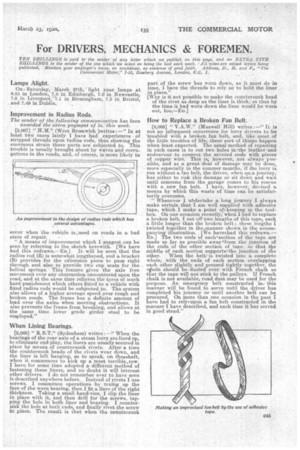For DRIVERS, MECHANICS & FOREMEN.
Page 25

If you've noticed an error in this article please click here to report it so we can fix it.
TEN SHILLINGS is paid tothe sender of any letter which we publish on this page, and an EXTRA FIVE SHILLINGS to the sender of the one which we select a.s being the best each week. All notes are edited before being published. Mention your employer's name, in confidence, as evidence of good faith. Address. D., M. and F.. The Conimercial Motor," 7-15, Rosebery Avenue, London, E,C. I.
Lamps Alight
On Saturday, March 27th, light your lamps at 6.53 in London, 7.8 in Edinburgh, 7.0 in Newcastle, 7.6 in Liverpool,"-7.1 in Birmingham, 7.3 in Bristol, and 7.49 in Dublin.
Improvement in Radius Rods.
The sender of the following communication has been awarded the extra. payment of 5s. this week.
[2,067] " H.M." (West Bromwich )writes:—" In at least two cases lately I have had experiences of stripped threads upon radius rods, thus showing the enormous strain these parts are subjected to. This trouble is usually brought about by waves and corrugations in the roads, and, of course, is more likely to
occur when the vehicle is,used on roads in a had state of repair.
"A means of improvement which I suggest can be seen by referring to the sketch herewith. We have had this redrawn.—En.] Itwill be seen that the radius rod (R) is somewhat lengthened, and a bracket (B) provides for the extension piece to pass right through and also to provide two cup seats for the helical springs. This feature gives the axle free movement over any obstruction encountered upon the road, and at the same time relieves the tyres of much hard punishment which others fitted to a vehicle with fixed radius rods would be subjected to. The system also allows of a higher average speed pver rough and broken roads. The frame has a definite amount of lead over the axles when meeting obstructions. It also prevents the frame from breaking, and allows at the same . time lower grade girder steel to be employed."
When Lining Bearings.
[2,068] " R.B.T." (Sydenham) writes :—" When the bearings of the rear axle of a steam lorry are lined up, to eliminate end-play, the liners are usually secured in place by means of countersunk rivets. After a time the countersunk heads of the rivets wear down, and the liner is left hanging, .so to speak, on thekeshaft, when it commences to kick up a most terrible,row. I have for some time adopted a different method of fastening these liners, and no doubt it will interest other drivers. I do not remember ever to have seen it described anywhere before. Instead of rivets I use screws. I commence operations -by truing up the face of the worn bearing, then! fit a liner of the right thickness. Taking a small land-vice, I clip the liner in place with it, and then drill for the screws, tapping the hole in both liner and bearing. I countersink the hole at both ends, and finally rivet the screw in place. The result is that when the countersunk part of the screw has worn down, as it must do in time, I have the threads to rely on to hold the liner in place." [Why is it not possible to make the countersunk head of the rivet as deep as the -liner is thick,' so that by the time it had worn down the liner would be worn Out, too.--Fn.]
How to Replace a Broken Fan Belt.
L2,0691 " V.A.W." (111uswell Hill) writes: —" It is not an infrequent occurrence for lorry drivers to be 'troubled with a. broken fan belt, and, like most .of the little troubles of life; these sort of things happen 'when least expected. The usual method of repairing in such cases is to cut twb holes infthe leather and endeavour to connect the severed ends with pieces of copper wire. This is however, not always possible, and as a great deal of damage may be done, more especially, in the summer months, if the lorry is -run without a.fan belt, the driver, when on,a journey, has either to risk this damage or sit down and wait until someone from the garage comes to his rescue with a new fan belt. I have, however,devised a means by which this waste of time can be satisfactorily overcothe. " Whenever I undertake a long journey Ialways make certain that-I am well supplied with adhesive tape, which I make a point ofi keeping in the toolbox: On one occasion recently,' when I had to replace a broken belt, I cut off.two lengths.of this tape, each a little longer than the broken belt these lengths I ' twisted together in the,manner shown in the accompanying illustration. . [We haveihad this redrawn.— En.] The two ends of each4section of the tape are made so far as possible awayqrom the junction of the ends of the other section of tape, so that the middle of each section supports 'the junction of the other. When the belt is twisted into a complete whole, with the ends of each section overlapping each other slightly and pressed tightly together, the vihole should bedusted over with French chalk so that the tape will not stick to the pulleys. If French chalk is not available, road dust may be used for the purpose. An emergency belt constructed Me this manner will be found to serve until the driver has completed his journey or until another belt can be procured. On more than one occasion in the past I have had to rely' upon a fan belt constructed in the manner I have described, and each time it has served in good -stead."


























